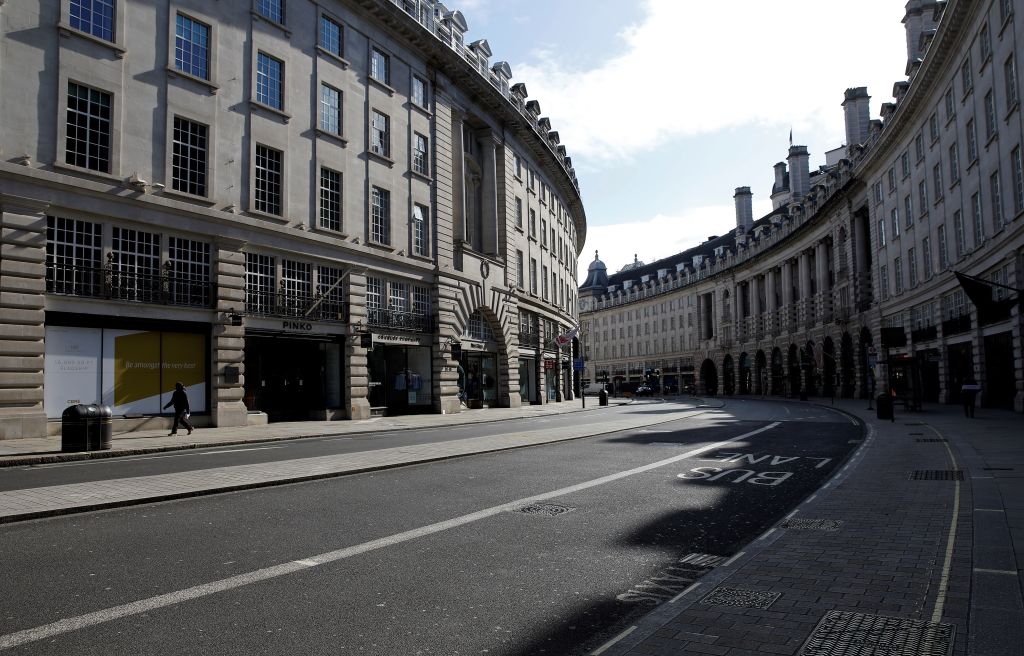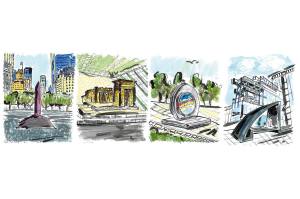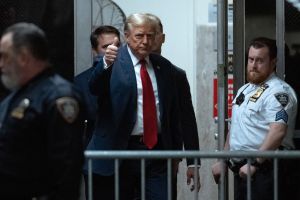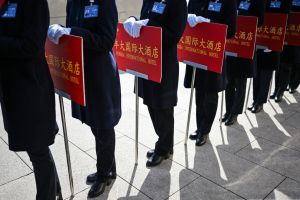COVID-19 has a horrid ability to turn fiction into fact. Deserted modern cities are usually the realm of post-apocalyptic sci-fi movies. Now, many of us live in them. The world’s greatest streets are dramatically empty; suspended suddenly in a dream-like quiet. It’s eerie and also very beautiful.
We usually often don’t notice how remarkable our cities are the commotion. We are distracted by the crowds, the commotion and the congestion. Now it is hard for urbanites to notice anything else. The Spectator has looked around the world, and asked various writers in various places to describe where they live in lockdown.
Washington DC

It’s a shame we can’t always see the Cherry Blossoms in peak bloom without Instagram influencers and tourists, as the large crowds mask their majesty. Avid runners and bikers know the best times to catch the branches hanging over the Tidal Basin or stare down the national mall from the Lincoln Memorial are early in the morning or late evening, when there are no bused-in school children and Segway tours.

The empty pathways downtown during the coronavirus outbreak are at least a pleasant reminder that our national monuments are far more beautiful than the average tourist trap.
Paris

For years the Paris mayor, Anne Hidalgo, has been striving to reduce the number of cars in the city and her wish has inadvertently been granted. In 2019 the French capital registered record levels of pollution, but you can already feel the difference in air quality because cars have been banned except in exceptional circumstances.

Not only is Paris cleaner but it’s quieter. It’s estimated that 17 percent of Parisians fled to the countryside before the lockdown began and it feels like August (when Parisians traditionally jet off on their holidays) has come early this year. To be honest, it’s bliss. Vive le confinement!
Los Angeles
The most famous symbols of Los Angeles are almost always on display year round; the Hollywood sign, the palm trees, the beaches and the perfect weather. But other than our celebrities, what we are most famous for is our traffic — the worst in the United States. And it turns out, LA doesn’t feel like LA without it.
We don’t have a crown jewel landmark like the Washington Monument or one area of town that is busier than others like Midtown Manhattan. Everything is crowded, all the time, everywhere. But as the world has come to a halt, the arteries of the city are suddenly, blissfully, unclogged. What is normally a 60-minute drive takes 15 minutes.

Over the past decade as more tech has moved into the city, the Westside has transformed from kooky Cali bum life to Silicon Beach. Santa Monica and Venice have borne the brunt with increased rents, noise and construction. Normally the iconic boardwalk would be mobbed this time of year with tech bros, what’s left of the locals, people building sand sculptures for change and families on Spring Break, a pale dad with a sunburn holding his wife’s hand. She dons a visor and an ‘I heart LA’ shirt. Their embarrassed teens lag behind.
The once sleepy beachside communities of Santa Monica and Venice have returned to their roots. Gone are the foreign backpackers on the cannabis tour. Gone are the red Hollywood bus tours filled with gawkers hoping to catch a glimpse of Jennifer Garner at the Farmer’s Market or Lady Gaga in her car. The greatest silver lining has been the overnight disappearance of every Bird scooter in the city.
But seeing not a single person on the beach is surreal. Risking a ticket to take it in, you feel like the last person on Earth. It’s a strange dichotomy of wishing that this is what LA could be like all the time while also realizing that LA without the traffic, although wonderful, just isn’t herself.

The ferris wheel remains illuminated but empty — a perfect contrast and a beacon of hope that someday, maybe, things will go back to the way they were.
London

Bicycling into my office in Fitzrovia every day has been a voyage into the surreal and the desperately sad.
Empty London isn’t silent. You can now hear the noises that were always there but were drowned out before: squawking seagulls and cooing pigeons; the heating units in neighboring shops; the soft buzz of the photocopier in my office.

A few workers scurry about but otherwise the streets are deserted, except for the saddest sight of all — the homeless. Usually, I’m afraid, they melt into the background of the crammed streets. But now they stand out prominently — the only stationary people in the city, the only permanent witnesses to the oddest time in London’s history since the war.
Boston

Few sights are more heartening than a college town without students. One of them is a college town without professors. Not only have the Harvard students unclogged the streets and roads of Cambridge, Massachusetts, taking their stink of weed, poorly dried laundry, unfinished takeout and bottomless sanctimony back to their disappointed and indebted parents. The professors have disappeared too. All over town, the Subaru Foresters are stilled and the Toyota Priuses lie silent. For decades, the drug-addled, pampered babies of Harvard have talked about revolution. Now it has happened. For the first time, we can walk through Harvard Yard without stumbling over student folk singers, tourist parties being guided to touch the foot of John Harvard’s statue, and globally famous thinkers frowning as they attempt to put one foot in front of the other. At last, we may consider the architecture of Harvard’s halls without their inhabitants blocking the view. And what do those redbrick blocks with their ranks of uniform windows and single doorways resemble? A poorly planned 19th-century lunatic asylum. Function follows form.

Boston Common is one of those places where the American nation began and, judging from what the Common usually looks like, will end in drugs and disorder. Henry James, were he to amble down from Back Bay to the Common, would hail the first taxi to Logan airport, all his fears of barbarism confirmed. The spot from where this photograph was taken, looking northwards from the bottom-right corner of the Common, is usually a great place to go if you want to score hard drugs, be robbed at knifepoint, or sell hard drugs to the students of Emerson College and then rob them at knifepoint. Sadly, all economic activity in our fair city has, like the imagination of Henry James, gone into an animated suspension in which everything speaks of a horror that no one can name. Instead, we contemplate the exposed southern flank of John Winthrop’s ‘city upon a hill’, with its aspirant classicism and civic pride, its gleaming statehouse and cultivated Athenaeum, its historical self-awareness and — clearer than usual because the city is empty — its spectacular declivity into a backdrop for tourism and al fresco criminality. Winthrop, incidentally, would not have stood for this. He called democracy ‘the meanest and worst of all forms of government’, persecuted the Quakers for not being Christian enough, and was a great admirer of witch trials. He would have enjoyed the last civic festivity to be held on the Common before the great pestilence descended upon the libs, a rally for Bernie Sanders.
Tokyo

Sensō-ji Temple in Asakusa normally receives 30 million visitors a year. Now, the swarming mass of selfie-stick-brandishing tourists wandering along Nakamise Dori in search of souvenir fans and kimonos and refreshment in the innumerable sushi, tempura and green tea ice cream emporia has vanished. Ironically, thanks to COVID-19, the ancient shrine has seen its original function as a haven of peace and contemplation temporarily restored. But, for once, there is no one there to appreciate it.

Tokyo’s few parks, usually as busy on fine spring days as major shopping thoroughfares, are now closed. This has inconvenienced joggers and cyclists, geriatric synchronized exercise groups, courting couples and cosplay fanatics, not to mention the homeless, seeking a natural refuge from Tokyo’s endless panorama of concrete and neon. It has also meant the cancellation of many cherry blossom-viewing parties, a seasonal highlight for Tokyoites. Allegedly, though, this didn’t stop Prime Minister Shinzo Abe’s gaffe-prone spouse Akie partying under the blossoms with her friends.
Vancouver
Once teeming with rich suburban youngsters, out for a Friday night drive, both aimless and muffler-less, the streets of Robson are pleasantly quiet. The shops, normally full of tourists who surely have access to yoga pants and Nikes in their own countries (ironically and notably manufactured in said countries), are now boarded up to prevent theft. Of all the streets in Vancouver, Robson, in the downtown core, might be the worst. No Vancouverite of quality or conscience would intentionally choose it for a stroll or a drive, so it had been abandoned to the masses who didn’t know better.

Today, the streets are emptied of both the basic and gaudy — the ridiculous men, packed into equally ridiculous vehicles, have been forced to put their pursuit of appropriately douchey young women on hold, cockblocked by Her Highness, Princess Corona. Perhaps, like the imagined dolphins returning to the Italian canals and the gangs of wild turkeys commandeering the streets of Oakland, Vancouverites can at long last flock back to Robson, reclaiming Starbucks and Lululemon, just like Mother Nature intended.
Jerusalem
Last weekend, at the height of the coronavirus crisis in late March, I went to the Old City of Jerusalem. Usually bustling with thousands of tourists, pilgrims and religious believers from all over the world, it looked like a ghost down. In the Jewish quarter near the Western Wall, the holiest site in Judaism because of its proximity to the former Temple, there were just a handful of men and women coming to pray. This vast courtyard and the buildings across from it where many Yashivas (religious seminaries) are located, was quiet. Gone was the bustle and endless movement of people, most of them dressed in black, that come to pray on Shabbat. This cast a sense of foreboding over the whole area, as if something terrible had happened.

The change in Jerusalem at the holy sites has been immense and hard for people to take in. This is the period of Passover and Easter and soon Ramadan, when so many people converge on Jerusalem at holy sites located near one another, to pray and celebrate. It’s all deserted now. The Western Wall has no soldiers, no elderly religious men, or circles of singing youth.
Israel has attempted to lock down most of the country since mid-March with increasingly harsh orders that order people to stay within 100 meters of their homes. Most Israelis live in apartments so this has meant they have little space for themselves or their children who are now stuck at home as well. The Old City is no exception, the crowded markets and alleys are deserted.

The area where I live in Jerusalem is a middle class neighborhood of mostly professionals. It’s usually relatively quiet but the major thoroughfare outside has endless traffic going back and forth. Sirens are frequent due to a nearby hospital. The honking of car horns is also frequent during rush hours. However these days it is mostly an empty street. The cars are gone and police sometimes set up a checkpoint on the road or patrol to see if people are breaking the lockdowns. Even though people are permitted to go out near their homes, few people do. The playgrounds are empty.
There is a soccer field across from our apartment where I’ve noticed that some neighborhood youth sneak in to kick a ball around. This seems to be the exception, the few people who resist the government’s orders. They observe the social distancing guidelines of course by playing a game where people are rarely in contact. But the powers-that-be believe that going for a walk by yourself is some great danger, and has led everyone to believe they should stay home. The feeling of being imprisoned in a world that has ground to a halt is immense. And the feeling that our neighborhood will not be the same after for months or years, is dawning. When will we hear people walking outside again, or playing music or see youth running? The quiet is only interrupted by sirens from time to time. And our neighbors, who we’ve never seen before, seem to be festooning their garden with things for their kids to do. On the positive side we are enjoying our balcony more, looking out over the deserted and quiet streets and getting to hear the birds chirp for the first time in years.
New York City
There was a brief period in the last five years where I lived in Washington DC rather than New York. Whenever I revealed that I spent most of my time residing in the Big Apple, I’d earn expressions of disdain. ‘Ugh,’ people would say, ‘I hate it up there. It’s so busy and dirty and loud, you can barely even make your way up the sidewalk. I hate New York City.’
Whenever this conversation happened, I would take the person’s face into my hands, like that scene in Midsommar, and stare them intently in the eye. ‘No,’ I would reply. ‘You don’t hate New York. You hate Midtown.’ For Midtown is the reason other Americans have reviled New York for decades. A minute being shunted around Times Square by a small cast of cartoon characters, rubberneckers, comedy show hucksters and Naked Cowboys is often at fault for a lifelong bad impression of the city.

The area has, apparently, evolved since the 1970s, when it was a hotbed of iniquity, playing host to brothels and porno theaters. The advertising is just as brazen as back then, even if the products are slightly more upscale (with the exception of the Xinhua News Agency, of course.) Grand Central station is also much cleaner, as you can now see the signs of the zodiac celestial ceiling that had been obscured by years of cigarette smoke and pollution.

Today Midtown is home to every chain restaurant imaginable and a smorgasbord of knockoff Irish pubs. They’re all shut now, unless you’re ordering takeout or delivery. The streets are clear of tourists, the costumed characters are quarantined in a bedsit somewhere and there are no late night comedy shows to catch. Plus you’re not even allowed to touch your own face, let alone hold someone else’s to make a point.
Without a doubt Midtown is the least appealing part of New York City — if not any city — but by God do we need it back.


















